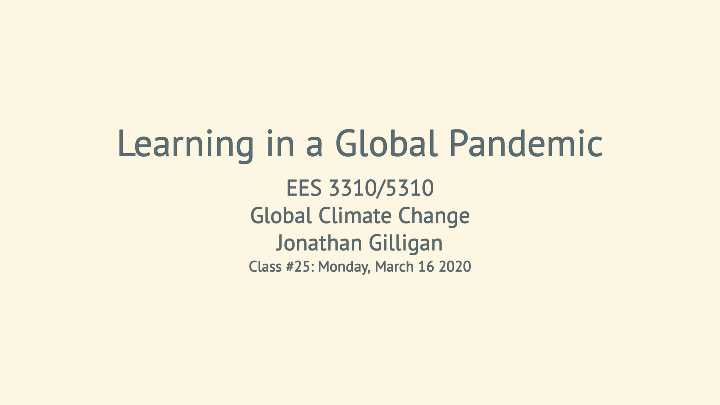



Learning in a Global Pandemic Learning in a Global Pandemic EES 3310/5310 EES 3310/5310 Global Climate Change Global Climate Change Jonathan Gilligan Jonathan Gilligan Class #25: Class #25: Monday, March 16 Monday, March 16 2020 2020
Meeting via Zoom Meeting via Zoom
Meeting via Zoom Meeting via Zoom Some basic hints Some basic hints With many of us online, please mute your microphone unless you’re talking, to keep background noise down. Use the chat feature Also non-verbal communication If your connection is spotty, turning off your own camera can free up bandwidth for audio and incoming video.
Examples Examples
[style=“height:750px;”]
Examples Examples
[style=“height:750px;”]
Examples Examples
[style=“height:750px;”]
Examples Examples
[style=“height:750px;”]
Examples Examples
[style=“height:750px;”]
Piazza Piazza
Piazza Piazza
Piazza Piazza
How are you doing? How are you doing?
Goals for the semester Goals for the semester
Goals for the semester Goals for the semester What do you most want to learn from the rest of this course? How can we structure the class to be most useful to you?
Topics in original syllabus Topics in original syllabus Kaya identity and policy analysis for clean-energy transition Economic perspectives on climate change Identifying goals of climate policy Putting a price on greenhouse gas emissions Intergenerational justice and the value of time Limits of economic approaches Clean energy technology Renewable energy Nuclear energy Geoengineering Manipulating Earth’s albedo Removing CO 2 from the atmosphere Policy: History of US & international climate policy Pragmatic policy options: Ideas for doing better What would you like to focus on?
Organizing the Semester Organizing the Semester Options: Zoom classes Pre-recorded lectures with discussion on Piazza Pre-recorded lectures followed by Zoom discussions Mixture of the above Other options
COVID-19 Pandemic COVID-19 Pandemic
COVID-19 Pandemic COVID-19 Pandemic Unprecedented in our lifetimes This includes my lifetime and my parents’ lifetimes Coronavirus A common category of virus Several deadly coronavirus epidemics: SARS (Severe Acute Respiratory Syndrome) 2002–2003 epidemic 8096 people infected, 774 deaths MERS (Middle-East Respiratory Syndrome) 2012–present (outbreaks in 2012, 2015, and 2018) Total impact: 2500 cases, 862 deaths COVID-19 (2019 coronavirus disease) So far: 170,000 infections, 6,513 deaths
Why Is It so Dangerous Why Is It so Dangerous Long period when people are contagious but don’t show symptoms Many infected (and contagious) people only have mild symptoms or no symptoms at all 80% of infected people suffer only a mild illness 20% suffer severe symptoms Very little risk for healthy people under 50 Immunocompromised young people are at high risk Above 50, risks rise rapidly: Around 5% of people 60–69 die. Around 10% of people 70–79 die. Around 20% of peopel 80–89 die. Spreads rapidly: On average, each infected person infects 2.2 others Reducing interpersonal contact is crucial to slowing spread Avoid unnecessary interpersonal contact outside houeshold Isolate infected and exposed people Practice good hygiene
Rapid spread of COVID-19 infections Rapid spread of COVID-19 infections China, US, S. Korea, Iran, most of Europe, etc. Case count rises around 33% per day 7.4-fold increase per week Today, US has about 3,700 cases If this continues: In a week this would become 27,000 In 2 weeks this would become 200,000 In 3 weeks this would become 1,500,000 Singapore, Hong Kong Reduced spread from 33% per day to 3.3% per day 1.3-fold increase per week instead of 7.4-fold After 3 weeks, US would have 7,000 cases instead of 1,500,000 Image credit: John Burn-Murdoch, Financial Times Aggressive containment: Extensive testing Contact tracing (Singapore) Enforced quarantine
COVID-19 is like climate change on fast-forward COVID-19 is like climate change on fast-forward Aggressive early action, before the problem seems severe is most effective at preventing a crisis If we fail to act early, it becomes much harder to control the problem A “wait and see” policy means waiting until there is a crisis and options are limited Both have tipping points For COVID-19, when there aren’t enough hospital beds, ventilators, etc. Both are collective action problems. Both are global problems that need coordinated action by all the nations of the world. Prominent political figures have attempted to avoid taking difficult decisions by claiming both problems were “hoaxes”. In both cases, failing to take the important early actions does not mean it is too late to make a big difference. We can still do a lot to keep bad situations with the pandemic and climate change from becoming catastrophes.
Recommend
More recommend